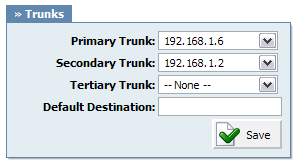System uses its trunks to place calls to various destinations. In order to allow an organization to control its voice communications budget and to provide for termination backup the default trunks allows setting primary, secondary and tertiary trunks.
System will use primary trunk as its first choice for every destination called. If primary trunk for same reason fails to terminate the call, the secondary trunk wild be used by the system. If secondary trunk for same reason fails to terminate the call, the tertiary trunk wild be used by the system.

Table 20.46. Default Trunks
Precedence
Settings:
-
Default Trunks: All System calls go through trunks defined here
-
MiniLCR: Overrides 'Default Trunks' and sets a specific trunk for a destination
Extensions:
-
Trunks: Overrides 'Settings: Default Trunks'
-
Routes: Overrides 'Settings: MiniLCR'